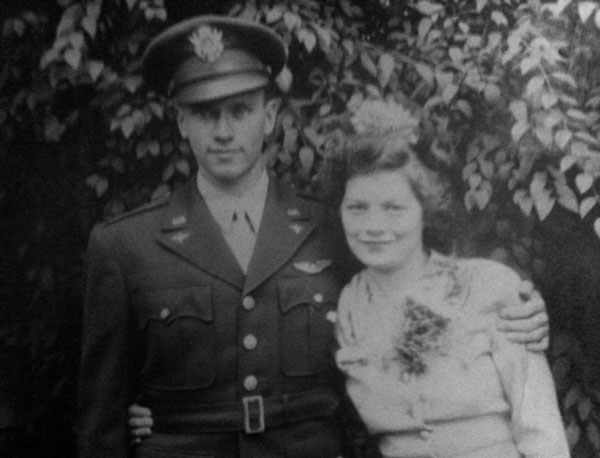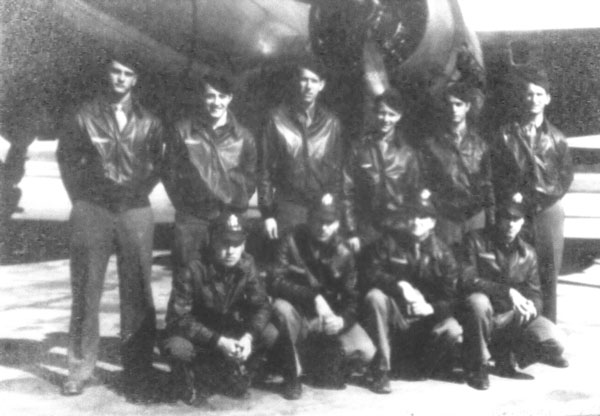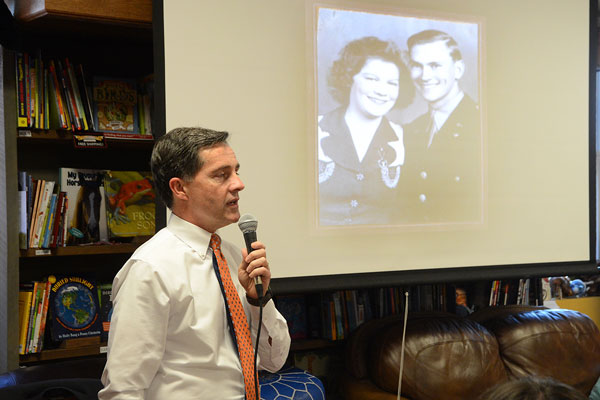A letter penned in 1944 uncovered the inspiring true story of Helen Gregg, one of eight children of Irish immigrant parents raised in the miseries of New York’s Hell’s Kitchen during the Great Depression, and Clarence R. Stephenson, a young man reared in the struggling small city of Ironton, Ohio. They grew up desperately poor, but always maintained an optimistic and hopeful countenance in spite of their circumstances. Helen not only suffered the effects of the poverty in which she was raised, but a father who was locked away due to mental illness, a sister who went into hiding to escape domestic abuse and the departure of four brothers who went off to war.
Patriotism inspired Clarence to become a combat pilot after the attack on Pearl Harbor. His training brought him to New York City during the summer of 1942, where Helen and the aspiring aviator literally ran into each other in Central Park. From the moment their eyes met, they knew their lives would never be the same. Not caring for the name Clarence, she called him by his middle name, Raymond. They were strangers and of disparate faiths, but no differences or conflicts, or so they thought, could keep them apart.

In August 1942, Raymond asked Helen to marry him before his return to Ohio’s Patterson Field. She initially said no, as she was just sixteen years old. Her mother forbid her to marry until she turned eighteen. Raymond said he would wait until her eighteenth birthday, or eternity if he had to, if she would say yes. More than a year later, September 6, 1943, became the happiest day of Helen’s life. It was her eighteenth birthday and the day she married Raymond.
After their marriage in Ohio, Raymond was moved about the country training to pilot the B-17, America’s Flying Fortress. Helen followed him by train and bus, so that they could be together before he went off to war. For Helen, the hardships of bus and train travel across the country alone were daunting. She had a brush with death on a mountain pass during a bus ride from New Mexico to Utah. She encountered poverty and confronted racism during her travels in the deep south. Raymond’s greatest challenges and heroic moments came in combat as a highly decorated B-17 pilot and flight commander.

On the afternoon of September 6, 1944, 1st Lieutenant and Flight Commander Raymond Stephenson and his crew received a briefing for a mission that would take them from RAF Watton, along the European Atlantic coast and out to the Azores archipelago that night. Joining Raymond on this mission was his co-pilot, Joe Ward; navigator, Eugene Swiatnicki; engineer, Earl Westerholm; radio operator Joe Minery; British meteorologist Marv Rogers, and gunners Lenny Licurse and Keith Clinton.
This mission would be a long affair. The assignment would exceed fifteen hours of flight time. This was an unescorted reconnaissance mission under the cover of darkness. In order to cover the considerable distance required to complete this operation, the payload and bomb ordinance that customarily occupied the bomb bays, was replaced with additional fuel tanks. The crew was scheduled for departure at 2245 hours.
Right on schedule after methodically completing the entire pre-flight checklist, Raymond taxied around the perimeter of the runway. The aircraft came to a full stop at the end of the airstrip awaiting clearance for takeoff. Raymond loved to get behind the controls of his B-17. Minery was sitting on the small seat in front of the radio man’s table. Clinton was seated on top of an A-3 bag (aviator’s kit/duffel bag) and Rogers was seated on the aluminum food kit box. They were the only three crew members aft in the aircraft.
The engines were run up and Stephenson gave it the gun. After an initial lurch, the Flying Fortress gathered momentum and accelerated down the runway. The sound of the engines was good and the speed of the aircraft more than adequate as it barreled down the runway. The shaking and rattling of a rolling behemoth of an airplane on the concrete air strip smoothed and dissipated as the Flying Fortress lifted off the ground and headed skyward.
Moments later, Marv Rogers heard an explosion above the roar of the engines. He felt a forceful, jarring sensation. In the darkness, peering through the radio man’s compartment window, he saw bursts of light and flames. A powerful jolt knocked Keith Clinton off the A-3 bag. As he lay on his back on the floor of the aircraft, he saw flashes of fire outside through the windows of the B-17. Joe Minery was shaken by the severe trauma to their aircraft too.
“What the hell is going on?” He screamed into the radio.
The plane began to shake even more violently.
George McNerney, a British army private who was assigned to the Watton ground security squad, was performing a routine check of the Ack Ack sight, a battery of anti-aircraft guns located beyond the end of the runway from which Raymond and his crew lifted off. McNerny heard a loud sputtering of engines, followed by a louder roar. When he looked in the direction from which he heard the violent eruption, he saw a B-17 flying erratically at low altitude. There appeared to be fire, or terrific exhaust flame from the motors on the left side of the plane.
Inside the thirty-two ton Flying Fortress, the crew heard a command shouted from Joe Ward in the flight deck.
“Brace yourselves!”
There was a sudden loss of altitude and everyone was tossed about the aircraft. The crewmen felt their stomachs come up through their throats as the plane plummeted. Keith Clinton tried to gird himself against a fuselage support column, but couldn’t. He was thrown through a door to the waist of the plane and landed face first on the ball gun turret. He grabbed ahold of the ball turret and could feel the vibrations of the underbelly of the aircraft first slamming against the earth and then dragging along the terrain. As Marvin Rogers saw Clinton fall through the door into the waist of the plane, he was knocked to the deck by the collision of the aircraft with the ground. As their B-17 skidded and grinded along the earth, Marv saw flames shoot up through the bomb bay doors, even though the bomb bay doors were closed.
Private McNerny, still standing at the Ack Ack site, saw the aircraft plunge. One wing of the plane struck a large oak tree as it plummeted toward the ground. The aircraft struck the earth with a thunderous sound. The ground shook as all sixty-five thousand pounds of the bomber’s girth bounced and skidded across the English turf. Parts of the ship began to tear up, as a wing hit an anti-aircraft turret and the friction of the aircraft scraping against the ground sent the sounds of bending and sheering metal into the night.
The B-17 finally ground to a halt, with the engines of the left wing fully enveloped in flames. The fields and woods surrounding the fallen aircraft were littered with the guts of the B-17. Thousands of gallons of fuel and hydraulic fluid were oozing out of the plane, spreading over the area and seeping into the earth. The same highly flammable and volatile fluids escaping their fractured containers leaked throughout the interior of the aircraft, intermingling with the blood of injured crewmen. Bits and pieces of the wings, engines and fuselage were strewn about, transforming a once pristine meadow into a burning collection of debris.
Keith Clinton was lying on the floor of the waist of the aircraft as it grinded to a complete stop. Although dazed and battered, he picked himself up off the floor. Seeing that the plane was on fire, he forced open the waist outside door, seeking to escape the flames.
“Joe, Marv, this way. Let’s get the hell outta’ here!” Clinton yelled as he dove through the waist door to escape the spreading inferno.
“Keith, your hair’s on fire!” Minery called out, just a step behind Clinton.
Marv Rogers, bruised, bloodied, and disoriented, wobbled through the smoke and darkness trying to follow his crewmate’s voices. He stumbled to the waist door and crawled out on his hands and knees. The three crewmates clung close to the ground and looked back at the aircraft for Raymond, Joe, Earl, Gene, and Lenny. There was no sign of them outside the plane. Their hearts and their guts told them they had to try to re-enter the aircraft to get to the flight deck and pilot compartment, but their B-17 was completely enveloped in flames from the bomb bay doors all the way to the nose of the aircraft.
Singed and pummeled from the crash, Clinton, Minery and Rogers were still not out of danger. In addition to the risk of explosion, thousands of rounds of .50 caliber machine gun bullets for the B-17’s machine guns were still on board and commenced firing as the heat and flames reached them. The three dropped into a nearby ditch and watched helplessly as the engines burned and the surplus tanks in the bomb bays erupted in flames. Their five friends and brothers-in-arms were still unaccounted for. Keith Clinton peeked up over the edge of their earthen shelter. He could see the flight deck through the smoke and flames.
“Oh my God.”
“What is it Keith?” asked Marv.
“Raymond and Joe. They’re slumped over the controls in the cockpit.”
Minery poked his head up.
“We gotta do something.”
“It’s too late Joe.” Marv wept. “Dammit all. It’s just too late. Only one thing left to do.”
Keith, Minery and Marv crouched in that dirt hole and prayed for Raymond, Joe, Gene, Earl, and Lenny.
Officers, enlisted men, and civilians began to arrive at the crash site in droves along with medical officers, ambulances, and fire fighters. Ammunition and flares on board the aircraft continued to detonate. Keith, Marv, and Minery were able to crawl from their ditch toward awaiting medical staff. They were taken by ambulance to the base hospital. Miraculously, they suffered only minor injuries.
The flames emanating from the wreckage of the aircraft were not extinguished completely until 2:30 a.m. the following morning on September 7th. At about 10:00 a.m. the morning of September 7, Private McNerney, accompanied by the officer of the day, Captain Nimmo and a handful of medical enlisted men, entered the fallen B-17. They removed the bodies of Raymond, Joe, Earl, Gene and Lenny, from what was left of their aircraft.
The five dead crew members were buried in the United States Military Cemetery in Cambridge, England. Keith, Marv, and Minery attended the graveside funeral service. They prayed for their friends. They cried as the flags draped over their caskets were folded, the bugler played taps, and their crewmates were lowered into the earth.
Raymond died on September 6, 1944. It was Helen’s nineteenth birthday and their first wedding anniversary. A date that one year earlier marked the most joyful of Helen’s life, was now marred by death and despair. Six weeks before Raymond’s death, Helen gave birth to a beautiful daughter who would never see her father. Helen’s deep faith was her consolation.
Almost a decade later, Helen found love again and married another soldier, this one a combat veteran of the Korean War. Together, they had three sons. On Helen’s 80th birthday, exactly sixty one years after the fateful day when Raymond perished, her family gathered at her home to celebrate. During the course of the afternoon, she pulled one of her sons aside and asked for his help with something in her bedroom. Once in the room, Helen pulled an old wooden box from the depths of a dresser drawer and from it, pulled out a weathered envelope and letter. The return address read 1st Lt. CR Stephenson. The post mark date was September 6, 1944, the day Raymond died. Helen asked her son to read the letter to her.
“My Dearest Darling,” began the letter. It is a note that Helen read every year on her birthday for six decades. In it, Raymond professed his love for her, his desire to see his daughter for the first time and a promise to be home soon. Helen told her son the story of her first marriage, a topic that was never discussed in their home. She also revealed to her son, whom she called Raymond, that he was named after her first husband. Her son was fifty years old when he learned he was the namesake for a dashing and brave young aviator who perished in World War II. She also taught him precious lessons about faith, dreams worth fulfilling, a love that could never be extinguished, and promises that must be kept, no matter how long or how hard it might be to fulfill them.

Author Ray O’Conor abandoned his career as a bank President and CEO to write this story. Among his many accolades is this:
“Ray O’Conor abandoned his career to search for his namesake, a heroic B-17 pilot who died in World War II. What he found touches the heart and stirs the soul.”
James Bradley – #1 New York Times and National Best Selling Author of Flags of Our Fathers, Fly Boys and The China Mirage.
The book is available to buy at Amazon or can be obtained from any good book shop ISBN 978-160571-271-0


These people are the backbone of freedom and goodness on this planet. It is ironic that Raymond was killed, as my father was a WWII Navy veteran named Norman D. Stephenson. He served in the South Pacific as a coxswain mate on the small Marine LST’s. His younger brother Oscar Raymon Stephenson was a motorman on the large LST’s at Normandy, Omaha beach. Fortunately they both survived the war, as my middle name is Raymond(Clarence Raymond Stephenson). My oldest son Casey Ray Stephenson shares the same birthday as his Uncle Oscar Raymon of September 12.
The circle of life continues…..
A heart wrenching story well written
Thanks for posting Julian
Thank you for generous comments, John.
Best Regards – Ray O’Conor
I appreciate that, John.
Regards – Ray
A most beautiful and haunting love story Julian….Thank you so much for posting…
I am so grateful to Ray for allowing me to post it. It is indeed a moving story – reminiscent of the story of Hugh Dunford Wood of 21 squadron who died 6th June 1940 over Dunkirk. He married his sweetheart who had followed him to Watton on September 9th 1939. After his death, his widow remarried, and her son only discovered after her death, that his mother had been married before to Hugh when he came across a locket with a lock of his hair in, a sweetheart badge and an album of pictures. All of these she had kept to herself throughout her second marriage.
Like Raymond’s story, so sad.
Secrets of the Heart Julian…..
Thank you for your kind words, Dorothy. I’m glad you enjoyed Helen and Raymond’s story.
Thank you to Julian Horn for the opportunity to share this poignant and powerful story of two ordinary people who led extraordinary lives during the most tumultuous period in history. Author Ray O’Conor – She Called Him Raymond – A True Story of Love, Loss, Faith and Healing.